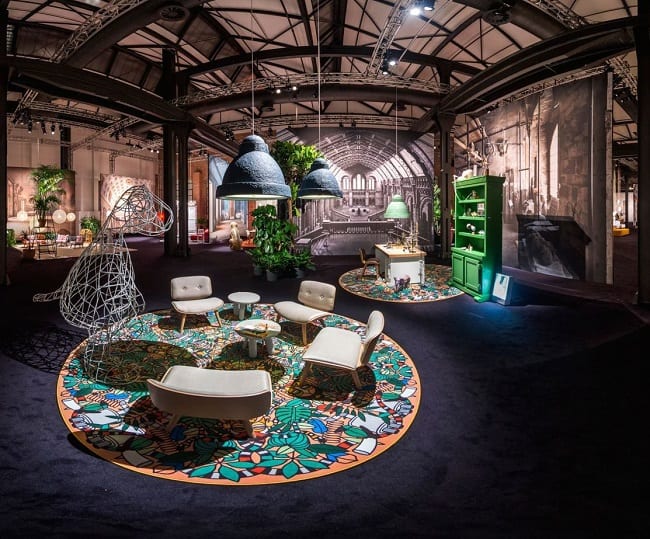Marcel Wanders remains one of the most exciting designers today. He is one of our three designers with Marc Newson and Jamie Hayon (see their linked posts below) who offered opinions at this year’s Milan Design Week about the state of design in 2104.
Dutch designer Marcel Wanders is, for our money, the most creative of the three (Newson is too institutional and Hayon can be too frivolous although he is, reluctantly, growing on me with his less saccharine work). Wanders also had the best interview with Dezeen. He raised an interesting dilemma: Is online design fantasia making real life products seem dull?
“You are so able to present every crazy idea as if it is reality, the whole universe of communication is so strong but now it’s difficult for a company to be anywhere as interesting in a world that is so dominated by prototypes and great and bright ideas. The Dezeens of this world are extremely inspirational, but have no realistic dimension any more.”
Wanders was speaking at the launch of the latest collection by Moooi, the furniture and lighting brand he co-founded in 2001 with Casper Vissers. Moooi (it’s a Dutch word meaning pretty or beautiful) has grown rapidly by recruiting a roster of international designers (including Jamie Hayon) to create unusual products that sit alongside new work by Wanders, who was one of a generation of Dutch creatives nurtured by conceptual design company Droog.
“It’s funny that in the 1990s Droog was doing all this wonderful work. It was interesting that we kind of invented something which I call today ‘virtual design’. We started making prototypes as if they were real, we communicated them in Milano as if you could buy them.
“Today, designers are able to get international attention for products that are not ready for market and in many cases don’t even exist as prototypes…Now all that is realistic is starting to look extremely boring in the world of all this inspirational stuff. It’s a really interesting problem that we’re going to face. It’s a bit difficult to be in such an exciting world because they to start to feel really boring.”
We study Wanders’s work further in the images which accompany this post.
Garth Clark is the Chief Editor of CFile.
Above image: The Mooi Booth at the Milan Design Fair this year.
Any thoughts about this post? Share yours in the comment box below.





Above are several Marcel Wanders ceramic designs: his classic porcelain Egg Vase from 1997, created by stuffing hard boiled eggs in latex condoms; two vases from his 1988 Blue Delft Series and a more recent work Untitled for Mooi. The untitled vase is a modern copy in porcelain of a 3,100-year-old jelly jar found in the wreck of a Chinese junk. Wanders has kept its off-kilter charm.






Showcased for the first time earlier this year at Cersaie, the international exhibition of ceramic tile and bathroom furnishings held in Bologna, Italy, the Marcel Wanders Collection for Bisazza Bagno.
The collection features a series of consoles and mirrors in black or white lacquered resin with smoked glass top, clearly inspired by Baroque furniture, in clear contrast with the “pop” design of white ceramic sinks and the imposing white fibreglass bathtub which reinterprets the classic icon of the bar of soap, soft and rounded.
“The collection derives its original concept from a fantasy of mine, taking a bath immersed in soap: the apotheosis of clean! […] The idea of presenting different periods in a single collection comes from one of my beliefs: people have two opposing forces within them, one towards an eternal dimension where things last over time, the other towards change. In my design I oscillate and move between these two poles, the old and the new, reassurance and innovation. I believe it is an answer to a very human feeling. The Wanders Collection reflects precisely this duality.”
It’s not just a design of bathroom furniture but the creation of a mise-en-scène
This is a French term that originates in the theater. It means, literally, “put in the scene.” For film, it has a broader meaning and refers to almost everything that goes into the composition of the shot, including the composition itself: framing, movement of the camera and characters, lighting, set design and general visual environment, even sound as it helps elaborate the composition. This is something at which Wanders excels at as one sees below from his booth design from Milan and the extravagant settings for the Mooi store in Amsterdam and other of his operatic installations. In later post coming soon CFile will be looking at the extravagant photography settings now being created to sell ceramic design.





The Mooi Booth at the Milan Design Fair this year.
Read the original interview on Dezeen
Visit Wanders’s bathroom collection
Read “Editorial | Milan Reveals Cracks in the Design Bowl”
Read “Design | Failing the Gender Equality Test”
Read “Design | Marc Newson: Cracks in the Design Bowl”
Read “Design | Jamie Hayon: Cracks in the Design Bowl”

FABULOUS MILAN…WISH HAD BEEN THERE. ASK ME ANYTIME !!
GENIUSES GARTH AND MARK!!
XXXX